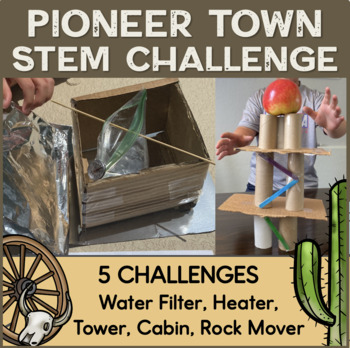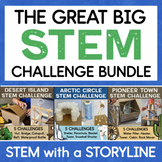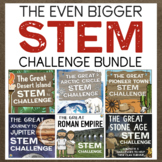STEM Activities Pioneer Challenge Science Bundle Set of 5 STEM Projects
- PDF
- Easel Activity
What educators are saying
Also included in
- STEM activities are a great way to integrate math and science into meaningful, hands-on learning! This bundle includes 3 themed-packs, each with its own engaging storyline. Students will help a stranded sailor escape a desert island, a group of explorers stuck in the arctic, and a pioneer family braPrice $21.50Original Price $28.50Save $7.00
- STEM activities are a great way to integrate math and science into meaningful, hands-on learning! This bundle includes all 6 of my "Stem With A Storyline" themed-packs. By completing each set of challenges, students will:help a stranded sailor escape a deserted islandhelp a group of explorers stuckPrice $42.00Original Price $57.00Save $15.00
Description
This is a set of 5 STEM challenges centered around the story of a pioneer family. After hearing about their travels west during the Land Rush of 1889, students will read about different parts of the journey. Each one will challenge them to design something to help the family build their new life.
Includes 5 different STEM projects:
- Thirsty Travelers: Design A Water Filter
- Home Sweet Home: Construct A Cabin
- Whose Territory?: Build A Tower
- Bath Time: Solar Water Heater
- Digging A Well: Design A Rock Mover
These STEM challenges use common materials that you probably already have in your classroom (see preview for suggested list). They incorporate concepts of linear measurement, area, force and motion, energy, simple machines, data, and scientific process.
Each challenge in this pack includes:
- teacher instructions
- student challenge sheet
- planning and design pages
- scoring rubric
There is also a set of team member role cards, design process cards, a master score sheet to find out which group is the most successful at helping the explorers, and associated NGSS standards.
This file includes both metric and standard/imperial versions.
PLEASE NOTE: One part of the storyline in this pack includes the term "Indians". The story is meant to appear as something written during pioneer times by a child whose family was traveling through unfamiliar territory. The term "Native Americans" was not used at that time (nor was "First Nations" which is not a term generally used in the U.S. even today). This was not written with any racist ideas or intentions. I do not refer to our Native peoples as "Indians" nor do I think we should teach our students to. However, this provides an opportunity for discussion about our nation's past and our treatment of native tribes allowing you to integrate social studies into this project.
_______________________________________________________________________
The challenges in this pack are highly engaging because students are involved in solving a real-life problem.
✪ "I am using these for a STEM camp that we are having at our school this summer. I love that they have a theme and a story for the students to relate to. It makes it more meaningful for them. Great projects and very detailed supply list. Wonderful resource!" - Teresa
✪ "I used The Great Deserted Island STEM Challenge and absolutely loved it!! I had to purchase the other two sets right away. My students are engaged, working together, and love the outcomes. Thanks for your hard work!" - Nicole
__________________________________________________________________________________________
FAQ
How long does each challenge take to complete?
This somewhat depends on the age of your students. I have found that the older students spend more time brainstorming and really planning their designs. They are also more careful when building and testing. Each challenge includes reading part of the storyline. This may take 5 minutes or 15, depending on if your students engage in conversation about it. Then students will need to brainstorm, plan, and collect their materials. The actual building and testing portion of the challenges usually takes about an hour. If you want your students to go back and make improvements to their designs, that will add more time. Overall, I would plan on using two class periods to complete each challenge from start to finish.
Why don't you list specific quantities for each material?
It is important to remember that STEM is a process that requires brainstorming, hypothesizing, planning, designing, and testing. If you tell students how much to use of certain items, they will use exactly that much. This completely defeats the purpose of STEM and turns it into doing a craft. We want students to think about what would work best to meet their goal. When you tell them exactly what to use and how much, you're doing the thinking for them. You can certainly limit how much students can take of each material. The challenges are very flexible. They include a list of suggested materials and note which ones are actually required. You can eliminate, limit, or add any other materials you like.
Do you have pictures of what the finished designs should look like?
I have included a few pictures in the preview but they are not part of the main file. Here's why... the second you show students what a successful design looks like, they will naturally try to copy it. There is no "right way" to complete a challenge. For example, a working bridge can be made out of any number of materials. It could be a truss bridge, suspension bridge, arch, cable, or beam bridge. Showing students what the finished design looks like gives them preconceived ideas that they will inevitably carry over into their brainstorming and design process. Again, this is doing the thinking for them.
Not sure where to start with STEM? See:
How to Choose the Best STEM Challenges for Your Students
NOTE: This resource may NOT be used for commercial purposes such as Outschool.








